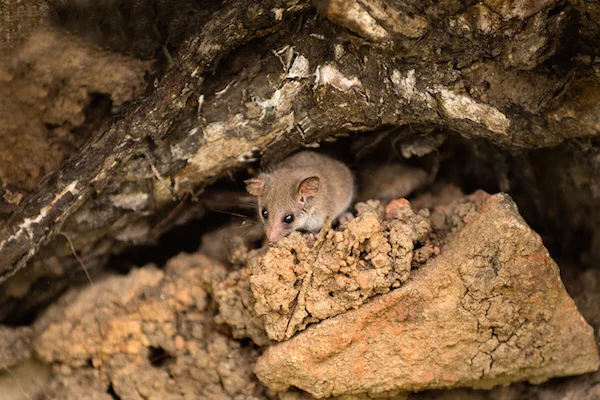They are tiny possums the size of mice.
They are furry and live mostly in forests.
Their tails can hold onto twigs.
They eat nectar, pollen, and insects.
They run about at night and sleep in the day.
A pygmy-possum is a possum that is the size of a mouse, with a tail that can curl around and grip branches. This is called a prehensile (say pree-hen-sile) tail. Like other possums, pygmy-possums are in the group of mammals called marsupials.
Pygmy-possums are nocturnal, which means they are active at night and sleep in the day in tree hollows. Because they are so small, it is difficult for them to stay warm in very cold weather, so they stay torpid, which means very sleepy and inactive, for a few weeks at a time in winter to save energy.
Like other possums, pygmy-possums are marsupials, which means the babies are born very tiny and undeveloped, and climb into the mother's pouch where they continue their development. They are then kept in a nest until they are fully developed.
Some different species of pygmy-possum:
Little pygmy-possum
Found in Tasmania, Kangaroo Island and in Victoria's mallee scrublands. It is found in several habitats, but not rainforest, in thick lower parts of the understorey. This is the smallest of all possums, weighing about 9 grams and measuring about 6.5 cm, with a 7.5 cm tail. Feeds on insects and lizards. Females give birth to 4 young, which move to the pouch and stay there for about 6 weeks. After this they are left in a nest, and sometimes ride on their mother's back as she moves about outside the nest.
Little pygmy-possum are classified as being of Least Concern.
Eastern pygmy-possum
Found in forests along the eastern coast of mainland Australia and Tasmania in forests and rainforests. Eats pollen, nectar from eucalyptus, bottlebrush and banksia, also some fruit & insects. Tongue has a brushy tip to gather pollen. The base of its tail stores fat, which helps it survive when torpid. Young move to the mother's pouch after birth and stay there for 30 days, then nest with their mother in tree hollows or in small, round nests of shredded bark, or abandoned bird nests
Eastern pygmy-possum are classified as Near Threatened.
Long-tailed pygmy-possum
Found only in Australia, in rainforests of northern Queensland. The tail is about 130mm long, about one and a half times the length of its body. The female's pouch opens backwards, or facing the back legs. They breed twice a year, in January/February and August to November. Female gives birth to 1-4 young, and has 4 teats in her pouch. The young stay in the pouch for 45 days after birth, then are kept in a spherical nest of leaves. Eat insects, nectar. They become torpid in very cold weather.
Long-tailed pygmy-possum are classified as Near Threatened.
Western pygmy-possum
Found in southern areas of Australia, in South Australia and Western Australia. They are very similar in appearance to Eastern pygmy-possums, but are a bit heavier, and are a more reddish colour with a white belly. They feed mainly on nectar, pollen, fruit and seeds, occasionally insects. They can breed any time of the year, having 2 or 3 litters of up to 6 babies.
Western pygmy-possum are not threatened.
Mountain pygmy-possum
The largest pygmy- possum: body 10-12 cm long, tail 15 cm. Found only in Mt Hotham in Victoria and Mt Kosciuszko in New South Wales, above the snowline. Once thought to be extinct, then re-discovered. Main threat is loss of habitat, which has been developed for skiing. Hibernates in winter. In summer eats Bogong moths, insects, spiders, worms. Stores seeds to eat in winter. When snow is over a metre deep, it gets about in tunnels close to the ground. They spend days at a time in torpor in winter.
Mountain pygmy-possum are classified as Critically Endangered.
Watch a video about mountain pygmy possums waking up after hibernating
https://www.facebook.com/abcnews.au/videos/809320033217416
©Video by ABC News ‘The Drum’ with permission.
Feathertail glider
It is the smallest gliding mammal in the world. Thin skin between front and back legs each side stretches when animal glides between trees (up to 20m distances). Has unusual extra pad on sole of foot for extra grip on vertical surfaces.
Found in forests and woodlands of eastern Australia. Arboreal (living in the treetops). Preyed on by owls and other birds such as kookaburras, snakes, large lizards, foxes, feral cats.
The tail looks a bit like a feather, which gives this tiny glider its name. ©Getty
Bluish grey colour, body about 8 cm long, and a prehensile tail about 8 cm long has fringe of hair either side so it looks like a feather.
Weighs less than 15 g. It feeds on pollen, nectar and insects.
Feathertail glider are classified as being of Least Concern.
It is always a good idea to use more than one source of information, so here are some others for you to investigate
• Read about the eastern pygmy possum:
• Read about the western pygmy possum:
• Read about the long-tailed pygmy possum:
https://animaldiversity.org/accounts/Cercartetus_caudatus/
• Read about the feathertail glider:
https://australianmuseum.net.au/feathertail-glider
• Read more about threats to the mountain pygmy-possum and watch a video about a conservation program:
http://www.zoo.org.au/healesville/animals/mountain-pygmy-possum








